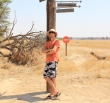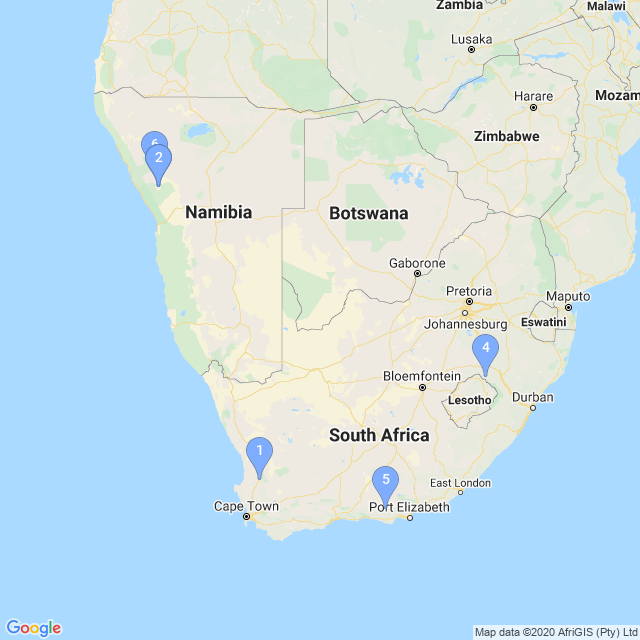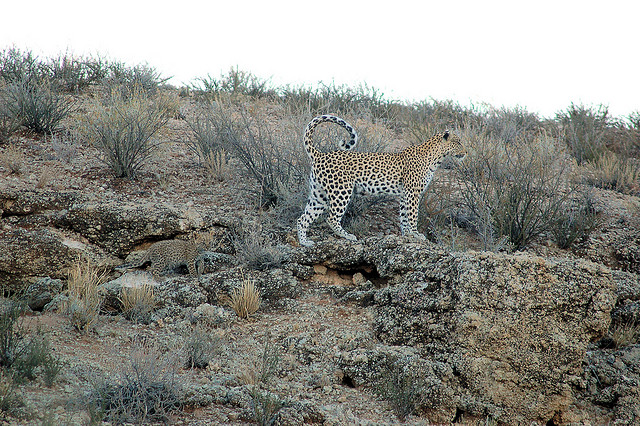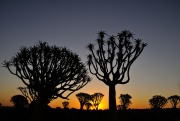Discover the Magic of San Rock Art in Southern Africa
I have always had a keen interest in the San (or Khoisan) rock art of southern Africa. The two main reasons for my enthusiasm are:
1. Rock art provides important documentation of the First Nations people in the region. It gives us insight into the way of life and psyche of the first inhabitants of southern Africa, the San people.
2. Viewing San rock art takes you to some incredibly scenic and remote locations!
San Rock Art Sites in Southern Africa
Southern Africa is best known for its wild animals, unique cultures, and breathtaking landscapes. It is, however, also renowned for its San rock art: ancient drawings hidden away in caves and overhangs. This rock art depicts the San tribe's daily life, hunting, rituals, spiritual beliefs, and wildlife. These drawings offer a snapshot of what they experienced thousands of years ago, mostly long before the first Europeans arrived.
 Gifbom possible depiction of alien visitation
Gifbom possible depiction of alien visitation
You’ll often find San rock art in places that are protected from the elements, in caves and rocky hills, thus, seeing these paintings often involves walking. Sometimes it takes a quick walk and at other times, a strenuous hike into mountainous terrain. This is part of the allure that drives enthusiasts to travel great distances in search of San rock art in southern Africa.
San Rock Art in South Africa
South Africa has the richest treasure trove of rock art in the world. You can see this ancient legacy of the San (Bushmen) people in national parks and nature reserves all over the country.
Find out more about the San people in Who are the Khoisan People?
Cederberg Rock Art, South Africa
Fortunately for me, not far from Cape Town (where I live) is an area called the Cederberg. It is about 3 to 4 hours drive North and is famous for its peculiar rock formations. It is one of my favourite places to view San rock art.
 Lotts Wife in Cederberg, South Africa
Lotts Wife in Cederberg, South Africa
The Cederberg is a popular weekend getaway, prized for rock climbing/bouldering, mountain biking, hiking, and outdoor camping. It is also a great destination to escape the city for some peace. In addition, there is very little light pollution, making it excellent for stargazing.
Here and in the surrounding areas, you will also find plenty of fine examples of San rock art.
 Central Cederberg, near Stadsaal Caves
Central Cederberg, near Stadsaal Caves
The Cederberg lies 200km north of Cape Town in the Western Cape. It stretches from the Middelberg Pass in Citrusdal to the north of the Pakhuis Pass at Clanwilliam. It covers 71,000 hectares of rugged mountains, making it a hotspot for hikers and rock climbers.
The Cederberg is part of the Cape Floral Region, a World Heritage Site. The area is covered in mountain fynbos vegetation and is home to varied wildlife. A great accommodation option is at Sanddriff, where you will even find an exceptional wine farm.
You will also find the Sevilla Rock Art Trail in this area, located just off the Pakhuis Pass outside Clanwilliam. If you travel South, you’ll find another famous lodge called Kagga Kamma, where you can camp in style inside a cave!
Further North (and lesser-known) is an area called Gifberg. The direct English translation of the name means ‘poison mountain’. The name originates from the deadly bush that grows in this part of South Africa. The San used this bush to make their deadly arrow poison.
 Gifbom sign at Poison Mountain
Gifbom sign at Poison Mountain
 Gifbom contacting the spirit world
Gifbom contacting the spirit world
You can visit all these and many more San rock art sites in the Western Cape of South Africa.
San Rock Art in the Eastern Cape, South Africa
Next, let’s head to the Eastern Cape, where I have visited an area called Baviaanskloof.
Unspoiled, rugged mountainous terrain Baviaanskloof offers a fabulous wilderness experience, with plenty of nature activities and many San rock art sites.
 Baviaanskloof bushman painting of shaman
Baviaanskloof bushman painting of shaman
The Baviaanskloof is also a biodiversity hotspot. Seven of South Africa’s eight biomes (major natural regions) are featured here including fynbos, forest, grassland, succulent Karoo, Nama-karoo, sub-tropical thicket and savanna.
San Rock Art in Mpumalanga, South Africa
Mpumalanga is one of the richest areas in South Africa for San "bushmen" art, but it is not well documented or studied, according to rock art researcher Mduduzi Maseko. Many of the sites in the province are being damaged by miners, including illegal miners, also known as 'Zama Zamas'. The Rock Art Research Institute does excellent work researching and protecting these sites.
 A shelter with many art styles in Mpumulanga by Mduduzi Maseko
A shelter with many art styles in Mpumulanga by Mduduzi Maseko
San Rock Art in the Drakensberg Mountains, South Africa
The magnificent Drakensberg mountains cover many provinces in South Africa, but the best San rock art is found in the KwaZulu Natal part of the mountain range. There are about 30,000 San paintings in this World Heritage Site. The Bushmen believed that the rock face was a veil between worlds, and the image of an Eland is often seen emerging from cracks in the rocks. Visitors must be careful to observe the correct protocols when visiting art sites, to avoid damaging them.
 A panel of Drakensberg rock art
A panel of Drakensberg rock art
San Rock Art in Botswana
Botswana has many sites to view San rock art, but the most renowned is Tsodilo Hills, located in northwest Botswana, which contains around 400 San rock art sites with thousands of individual paintings. These paintings are larger than most San rock art paintings, and are drawn with fingers instead of brushes, and were likely painted by the Khoesan (Khoisan), who were pastoralists.
 An eland with a calf at Tsodilo Hills
An eland with a calf at Tsodilo Hills
San Rock Art in Namibia
Namibia is an excellent destination for ancient San rock art.
Twyfelfontein in Namibia has one of the largest concentrations of petroglyphs in Africa. On my last road trip through Namibia, we included an overnight stay in Brandberg, to see The White Lady bushman painting.
Brandberg is also home to the desert elephant, which means you might share your campsite with these gentle giants. Our accommodation choice was Brandberg White Lady Lodge.
San Rock Art FAQs
When looking at San rock art and "Bushmen" paintings, the usual questions that come to mind are: how old are the paintings, what did they paint with, and what are the images meant to represent?
How old is San rock art?
A rock painting discovered at Blombos Cave is the oldest known instance of human art, dating to around 73,000 years ago.
The rock art in the uKhahlamba Drakensberg Park is about 3,000 years old. Archaeological dating techniques have improved a lot over the years. Today we have therefore confirmed that some rock art found there is about 3,000 years old, compared to the initial estimate of about a thousand years.
 Drakensberg San rock art by fiverlocker
Drakensberg San rock art by fiverlocker
What did the San use for paint?
The San used red, brown, and yellow pigments as paint. They made white paint from white clay or bird droppings, and black from manganese minerals and charcoal. They never used blue and green. The blood of an Eland was often mixed with the pigments. They made their brushes from animal hair or bird feathers.
Why is San rock art important?
San rock art is important because it represents one of the earliest forms of creativity in humans. It is also the first evidence of humans being able to document storytelling. These artworks also help us better understand the culture of early hunter-gatherer societies.
San rock art depicts the religious beliefs and practices of the time. The rock paintings provide us with insight into the lives of the San people. The San (or Khoisan people) would draw the art in a trance-like state. This trance-like state was brought about through medicine, dancing, and drumming. It was a way in which the artist could connect with their ancestors and the spiritual world.
Interesting facts about San rock art
The San people believed in ‘Kaggen’ – the creator of many things. Kaggen translates to ‘mantis’ which is why the San tribe respected the praying mantis.
San rock art often depicts human figures with long sticks and animals galloping or leaping.
 Central Cederberg, Stadsaal Caves
Central Cederberg, Stadsaal Caves
In rock engravings, animals are more common than human figures. The eland (an antelope species) is often seen in San rock art.
 San Rock Art, Drakensberg by puffin11k
San Rock Art, Drakensberg by puffin11k
There are still many San rock art sites dotted around southern Africa that I’d like to visit. The next two I plan to visit are Tsodilo Hills in Botswana and the Royal Natal Park, part of the uKhahlamba Drakensberg Park (World Heritage Site).
Where will your African adventure take you?
For advice about the best places to see San rock art in southern Africa get in touch with me.
Let me help you plan your next trip to a remote and scenic destination in Africa!
[This post was updated in March 2024]
If you liked this post, these trips cover similar ground…
- Kalahari Bushmen, Okavango Delta & Savuti Safari in Botswana
- Kalahari Desert Botswana Safari (Camping)
- Kalahari & Okavango Delta Lodge Safari in Botswana
- Botswana Camping Safari: Kalahari & Makgadikgadi Pans
- 13 Day Botswana Safari: Delta, Moremi, Khwai & Chobe
- 4 Day Cape Town Safari to Sanbona Wildlife Reserve

__banner.jpg)











 A native Capetonian, Daniel’s earliest explorations of South Africa were family camping trips to the then small fishing villages of Cape’s west and south coasts. After qualifying in travel and tourism he was soon discovering Southern Africa, like his uncle TV Bulpin; and adventures such as tandem skydive and Bloukranz bungee - which were captured on VHS! He headed over the pond where his ‘world tour’ took in Europe, North Africa and Central America, before returning home to live in a suburb internationally renowned for senior citizens and shark attacks. When he’s not answering your calls and emails, you’ll probably find Daniel in the bush, with no reception or running water, but camera poised.
A native Capetonian, Daniel’s earliest explorations of South Africa were family camping trips to the then small fishing villages of Cape’s west and south coasts. After qualifying in travel and tourism he was soon discovering Southern Africa, like his uncle TV Bulpin; and adventures such as tandem skydive and Bloukranz bungee - which were captured on VHS! He headed over the pond where his ‘world tour’ took in Europe, North Africa and Central America, before returning home to live in a suburb internationally renowned for senior citizens and shark attacks. When he’s not answering your calls and emails, you’ll probably find Daniel in the bush, with no reception or running water, but camera poised.

 For some of South Africa's best game viewing and stunning raw landcapes, away from the maddening hordes... Can you say Kgalagadi?
For some of South Africa's best game viewing and stunning raw landcapes, away from the maddening hordes... Can you say Kgalagadi?










